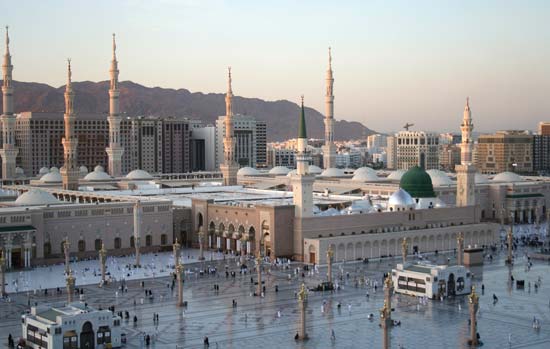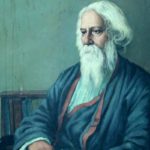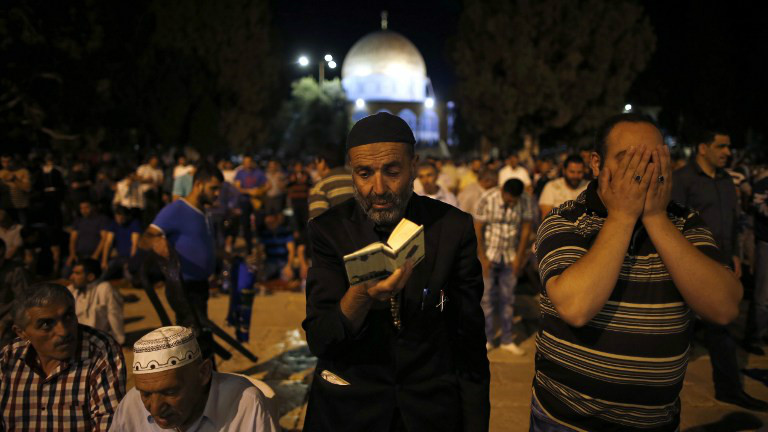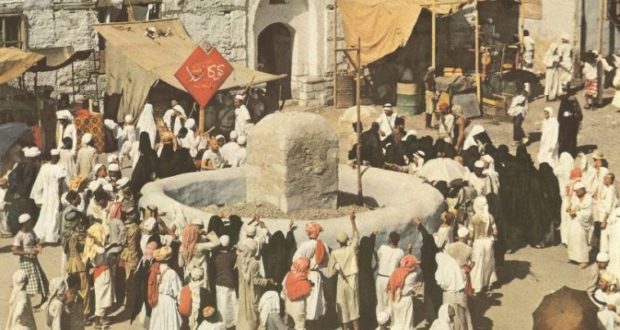For the believers, the city of Medina is a must-see destination. When theologians talk about places of religious significance, Medina features prominently in their list although none of the five tenets of Islam enforces a visit to the place. Muslims are not duty-bound to visit it.
Still, anyone who visits Mecca visits Medina. And why not?
It is the city of the Prophet Muhammad (peace be upon him) – by visiting it Muslims seem to get a feel of him, in the streets, city corners, the mosques and monuments and the mountains crisscrossing the vast terrains of Medina. Much of the city’s physical heritage has been destroyed – some with the passage of time, others designedly by the rulers of the land, out of fear that these might become objects of idolatry.
There are still plenty of sites and structures in this city of the Hejaz region of western Saudi Arabia that can satisfy the spiritual thirst of a visitor. They might remind one of the times when the Prophet and his companions and followers used to live there and rule the world.
Why is Medina so important, in a nutshell? First off, it is the second holiest city in Islam after Mecca – the birthplace of Islam. It is the place where the Prophet took up residence after migrating from Mecca. Then, it is also his burial place and that of the majority of his companions and family members.
Medina is home to the three oldest mosques in Islam, all notable for different reasons: Al-Masjid al-Nabawi (The Prophet’s Mosque), Quba Mosque (the first mosque in Islam’s history), and Masjid al-Qiblatain (the Mosque of the Two Qiblas, a reference to the divine ordinance for change of qibla from Jerusalem to Mecca). Even one who doesn’t subscribe to the fundamental principles of Islam might have to fight an urge to visit a place of such historical significance.
I visited Medina in 2011, and as strange as it may seem, discovered that this city could be an attraction for the scientists, too.
If you go to the city and ask people about the Mount Uhud, one in every ten will probably end up with a story of gold. They may tell you about gold ores and particles and such precious stones lying buried in the mountain. Uhud, a rocky mountain located north of the city centre, is approximately 1,077m (3,533 ft) high and 7-8 kilometres long.
I visited Medina in 2011, and as strange as it may seem, discovered that this city could be an attraction for the scientists, too.
One may wonder, however, if the idea of gold underneath Uhud was drawn from the Islamic scriptures where allegorical references were made to it more than once. The Prophet, while highlighting the importance of charitable giving, had once said: “If I had gold equal to Mount Uhud, it would not please me that it should remain with me for more than three days…”
On another occasion, he said, “Do not abuse my companions for if any one of you spent gold equal to Uhud (in Allah’s cause) it would not be equal to a mud or even half a mud spent by one of them.”
The same spirit was echoed in several other hadiths also – all connecting Uhud.
By my reckoning, reference to Uhud to suggest wealth and riches is exclusive in hadith. Though the Prophet had been to many hilly regions and mountains in his lifetime, he had a special liking for Uhud and mentioned it whenever he was required to exemplify wealth.
For him, another notable reference point in terms of wealth was the Euphrates – one of the two crucial rivers of Mesopotamia.
It can be argued that he mentioned these places as a metaphor for treasure because of contemporary notions of enormity/bigness typified by mountains, rivers and such massive natural phenomena. Uhud is one of the biggest, and by far the closest, hills from where the Prophet used to live in Medina. It might have seemed natural to him to use its name to suggest the enormity of the issues of his discussion.
But there are counterarguments, too.
Mohammad Yasin, an expatriate Bangladeshi living in Medina, on my enquiry, traced the gold speculations to a certain scientific investigation conducted by some scientists a few years ago. He said the scientists had tested the rocks of Mount Uhud and discovered proof of existence of gold ores. But then they were forbidden to proceed. Their request to further examine the place was turned down by the government of Saudi Arabia. The event, he said, went unreported.
It should be mentioned that Uhud is one of the holy sites of Islam and pilgrims usually visit certain parts of it while in Medina. Apart from a few marked places, most of the mountain is off limits to them. It’s possible that the government did not allow the said excavation attempt – or, wider access to the mountain for the pilgrims – considering its sacred value.
The car started moving on its own, and at one point, it was going about 100 kilometres per hour – all the while in neutral! On our way back, we came to know what it was like being at the opposite end of the force, struggling to speed up as if we were rowing against the current.
Apparently, Medina has more unsolved mysteries than one. While doing my rounds of the city outskirts, I came across a stretch of road in the mountains where some sort of magnetic forces seemed to be at work. My guide put our car into neutral as soon as we entered the road and told me to look at the speedometer.
The car started moving on its own, and at one point, it was going about 120 kilometres per hour – all the while in neutral! On our way back, we came to know what it was like being at the opposite end of the force, struggling to speed up as if we were rowing against the current. Later, I asked around for an answer but no one could say anything conclusive.
Some say the power of jinn is at work here, hence the name Wadi Al-Jinn (Valley of Jinns). Others point out to the theory of anti-gravity to explain the nature of the force, a phenomenon that is also evident in other rocky regions in the Kingdom, including the southern regions of Asir and Najran.
Strangely, one Arab News columnist mentioned locals who after staying in the valley at night reportedly said that they had heard voices asking them to leave. “You don’t belong here. This is our place,” the voices told them, according to the columnist.
Having said that, an integral part of the Islamic belief system is to keep faith in the statements (hadiths) made by the Prophet. Understanding the depth and layers of their meaning requires special attention.
If one considers the cases where the Prophet’s predictions, unintelligible at the time of their delivery, came true in later times, one would see the ingenuity of his references. Take, for example, the hadith where he predicted that the river Euphrates would “disclose the treasure of gold” at a given point of time in future.
It is only in modern time that we find the prediction come true.
A search on Google will bring you video clips showing how people on the banks of Euphrates are panning for gold and coming out of water victoriously. The prophetic reference to the disclosure of gold in the Euphrates served, in effect, to herald the coming of Qiyamah.
Speaking in the same vein, we may say that the reference to gold in Uhud may not be all that metaphorical. But any claim in this regard would need a factual basis and it’s up to the scientists to ascertain whether there is any. They can do so by using standard methods of scientific investigation.
My take on the matter? I would rather prefer scientists putting all gold-related speculations to rest – or, who knows, maybe performing a little miracle – to naysayers doing the thinking for me.














